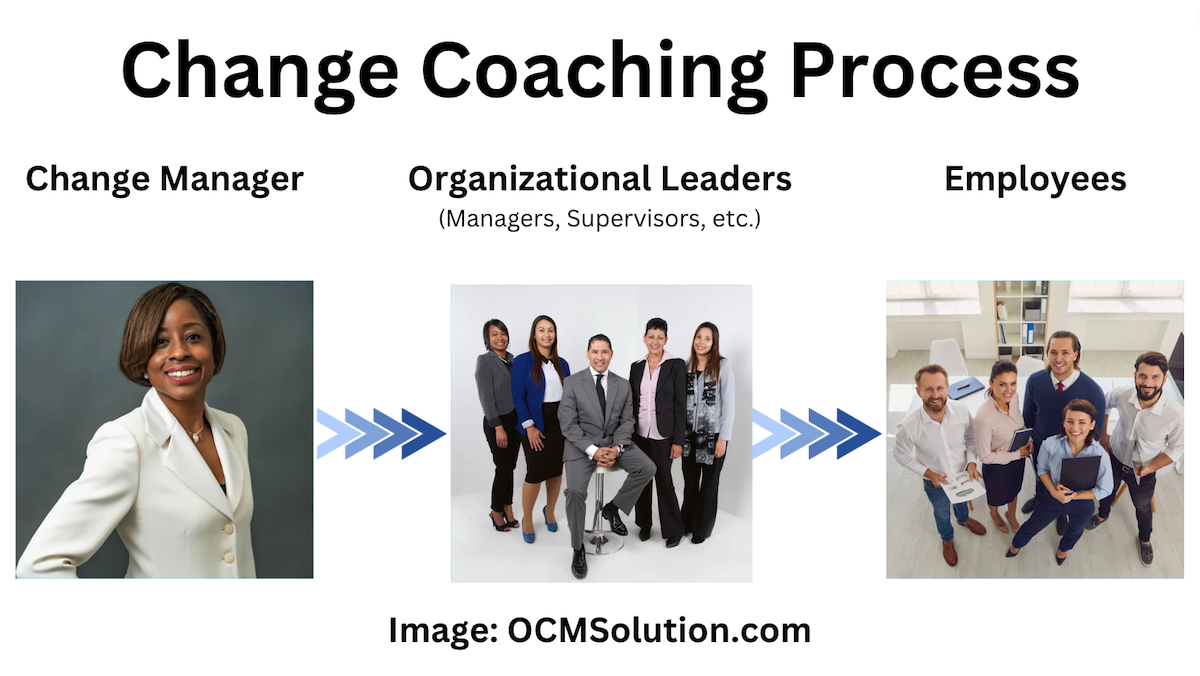Leading Successful Change Like a Fearless Explorer
Forget the dusty power suits and corner offices. The future of leadership in change management isn’t about barking orders from the top of the pyramid. It’s about becoming a fearless explorer, venturing into uncharted territory with your team by your side.
This article equips you with the essential maps and tools – the key roles leaders must play – to navigate the exciting, yet often treacherous, landscape of organizational change, highlighting the ever more meaningful importance of leadership in change management. So, ditch the corporate compass and get ready to chart a course for success together!

Story Highlights
|
The Vital Role of Leadership in Successful Change Management
Leaders play a critical role in change management projects, serving as guides for employees and setting the tone for the organization’s direction. Effective leadership communication is essential for successful change initiatives, as leaders need to understand their role in driving support for change.
Whereas, creating effective change leadership involves addressing resistance, identifying coaching needs, and implementing a structured coaching plan. With leadership support, change projects have a higher likelihood of achieving desired outcomes.
The Key to Organizational Success Through Effective Leadership Coaching
The optimal change leadership model involves coaching organizational leaders through change, empowering them to guide their teams effectively. This approach ensures a smooth flow of communication, as employees are most receptive to the managers they interact with daily.
Empowering Leaders for Organizational Transformation
The ideal role of leadership in change management involves coaching by the change management team, empowering leaders to guide their teams through the change process. This “one-to-many” approach maximizes efficiency and ensures consistent messaging.
Leadership significantly influences organizational behavior, shaping culture and employee morale. Employees often leave organizations due to dissatisfaction with their supervisors, highlighting the pivotal role of leadership in retaining talent.
Do you have any questions or feedback about change management and leadership? We’d love to hear from you. Reach out here.
The Essential Roles and Skills of Effective Change Leaders
Change leaders fulfill various roles, including:
- Advocating for change
- Facilitating communication,
- Managing resistance
- Acting as liaisons
- Mentoring employees.
These roles are essential for guiding employees through the change journey.
Key change leadership skills include:
- Listening
- Communication
- Empathy
- Visionary thinking
- Supportiveness
These skills enable leaders to effectively coach and mentor employees, driving successful change outcomes.
What Are Important Change Leadership Skills & Roles? Everything You Need to Know
Leaders play an essential role in any change management project. Organizational leaders are the ones that employees look to, day after day, for direction, support, and cues on where they need to direct their efforts.
When leading an organizational change project, leadership communication is a key ingredient to ensure a project is successful. If leaders aren’t coached on how leadership and change management connect, you can be left with a big gap when it comes to driving change support.
While change management leadership may be driving the change project, to gain the support of employees in the organization requires effective change leadership coaching, so managers, supervisors, executives, and other leaders know their role in the change project.

The Importance of Change Leadership
The optimal change leadership model is to have the change management team communicate and coach the leadership through change, and then those leaders will coach the employees they lead through the change.
This provides the best chain of communication when it comes to leadership and change because employees are likely to be most receptive to the manager they work with every day.
But, while leadership and organizational change both require similar skill sets, change management includes certain soft skills that not all leaders will have. They also may not be familiar with how change management works and terms like “resistance management” and “change agents.”
The role of the organizational change leadership team is taught by the change manager and change management team. So, it’s important to know how strategic leadership and change management work together and how to properly set up leadership coaching as part of your change management plan.
What You’ll Learn
In this OCM Solution insight article about the role of leadership in change management, we’ll cover everything that change management leadership needs to know about coaching leaders to support organizational change.
This will include:
- The difference between change management and change leadership
- The role of leaders in change management
- The importance of transformational leadership and change coaching
- The core change leadership skills
- How to create effective change leadership
See Also: Importance of Change Management in an Organization
What Role Does Leadership Play in Organizational Behavior?
Before we get into leadership and change management, let’s discuss the role of leaders in how an organization behaves. This will shed light on why leadership communication and coaching are a vital part of the change management process.
Leaders often set the culture in an organization. Employees will follow their lead on what’s considered important and what’s not.
For example, if you have a transformational leader that prizes innovation and challenges the employees that they lead to always think outside the box, the organization will most likely be one that’s continuously optimizing and improving efficiency.
If you have a leader that believes in going by-the-book and treasures structure and routine, then most likely those that work under that leader will be very rules oriented, but may not dare to “color outside the lines” for innovative problem-solving.
Managers, supervisors, and other leaders are often the most important component when it comes to employee behavior and employee morale.
While many people may think that pay is a major factor for employees leaving an organization, actually only about 12% of employees leave to make more money, according to CareerBuilder.
The #1 reason employees leave is related to the person they report to, the one leading them. According to NBC News, 79% of employees say they quit because they don’t feel they’re appreciated or recognized enough by their supervisor.
This leadership communication gap goes to show that leaders have a big impact on one of the most important parts of an organization, its employees.
Because leadership plays such a significant role in organizational behavior, the roles of leadership in change management are just as impactful and meaningful.
What’s the Difference Between Change Management and Change Leadership?
When you’re talking about leadership and change management, it’s important to distinguish between those who are part of the change management team and are leading the change effort and leadership in an organization that is tapped to help support the change.
The type of leadership and organizational change that’s the focus of this article are leaders in an organization that are coached to help support a change within their departments.
Change Management Leadership
The people in charge of ensuring a change project goes smoothly can be thought of as change management leadership. They consist of the change manager and others on the change management team.
This team will be the ones that teach change management leadership skills to leaders at all levels of an organization.
Organizational Leaders and Change Leadership
Company leaders that are being coached to help with organizational change leadership or anyone in an organization in a position that directly manages others can be considered change leadership.
This can be anyone from a department manager to an executive that manages the managers.
These leaders can include roles such as:
- Supervisor
- Manager
- Department Head
- CEO or other executives
- Regional Director
- Production Lead
- And more
For a change management project to be successful, those on the change team (the change management leadership) will need to coach the above leadership positions on the role of leadership in organizational change.
This will allow them to become part of the change leadership support team, helping drive the change at all levels.
This leadership coaching is a part of the change leadership model in any good change management strategy.
Don’t Miss: Should You Spend $4,400 for a Prosci Certificate?
Contact us if you have any questions or feedback about this guide on the importance of leadership in change management. Also, let us know if you have a role of leadership in change management PPT that you would like to share to help other change management practitioners.
What is the Role of Leadership in Organizational Change?
Leadership plays an important role when it comes to change. The role of leadership in change can either be a positive or negative one. Leaders have a lot of influence over those they lead, which is why a change manager wants to have them on the side of change support.
Leadership through change is essential because processes are being upended, and users are being required to adopt a new way of doing things. In some cases, they may be losing colleagues or changing departments.
Strategic leadership and change management best practices go a long way towards guiding people through change, addressing their concerns, and helping them accept and support the change.
Not every leader will have the same change management leadership skills, which is why the change management team makes leadership coaching one of its primary activities. It will give more guidance to those with less change experience and use more of a “touch base” approach with leaders well versed in the role of leadership in change.
When going through the coaching, the change management leadership team teaches leadership the answer to, “What is the role of leadership in organizational change?”
Ideal Role of Leaders in Change Management
The ideal role of leadership in change management is to be coached by the change management team on the change and change leadership skills. Then, the leaders are the ones to coach the employees that report to them.

Coaching in the Change Leadership Model
This is the ideal role of leadership in organizational change for three key reasons:
- One of the biggest obstacles to change is employee resistance, so it’s important they receive coaching and guidance to resolve it.
- During a time of transition, employees will be looking to their managers and supervisors, whom they trust, for direction.
- This allows the change management team to focus efforts on other parts of the change project using this “one-to-many” approach.
What is a “One-to-Many” Approach?
The one-to-many approach is one that takes advantage of transformational leadership and change management efficiency.
For example, you may have 300 employees in an organization and 30 leaders at various levels. If the change manager had to individually coach each employee through the change, while it could be done, it would not be the most effective method.
Coaching requires mentoring, check-ins, and managing resistance feelings, which can mean a lot of additional time for someone that is not directly working with an employee during the day.
If a change manager instead coaches those 30 leaders, and in turn, each leader uses the leadership and organizational change management skills they’ve learned to coach their direct reports, it’s much more efficient. The change manager is able to reach those 300 employees by coaching just 30 people (the leadership).
Change Management and Change Leadership Responsibilities
Ultimately, it’s the responsibility of the change manager and change management team to ensure leadership is not only onboard with the change project, but also appropriately coached so they can coach their team.
The role of leaders in change management is to take that message and training and use it to coach, mentor, and guide their team through the change, with the help of the change management team.
When leadership communication is done well during this coaching process, it helps resolve resistance and improve the results of the change project.
Related: Project Plan Template for Project & Program Managers
Why is Strong Leadership Important in Organizational Change?
When looking at the answer to, “What is the role of leadership in organizational change?” you have to consider what can go wrong if you don’t have strong change leadership.
According to an article on Meliorate, organizational change leadership is vital for project success.
Two of the main causes of change project failure have to do directly with the roles of leadership in change management.
The key reasons for a change project to failure are:
- Employee resistance to change (39%)
- Lack of support for the change from management/leadership (33%)
- Inadequate resources or budget (14%)
- Other obstacles (14%)
Good leadership through change is a key factor in mitigating employee resistance to change, so the two main causes of failure are both related to leadership communication and support during a change.
That means that a lack of proper change leadership by a company’s supervisors, managers, and executives is responsible for 72% of all change project failures.
The change leadership model is so vital because of the influence leadership has on an organization and the employees within that organization.
Strong leadership and leadership communication throughout the change project can help employees that are resisting the change see the benefits of the change project and help get their whole team on board.
When leaders and organizations are united in supporting a change, not only does it have a much better chance of achieving success, the entire process is easier because of that transformational leadership and change support.
Would you like to receive content related to the role of leadership in change management? Sign up for our monthly newsletter filled with OCM tips and knowledge.
What Does a Change Leader Do?
As part of the change leadership coaching process, the change management team will provide guidance for what a change leader should do to coach and mentor their direct reports through the change project.
Leadership and change management may come easier to some leaders than others. Everyone has a different leadership style, and some leaders may naturally be more of a mentor than others.
It’s the job of the change management leadership coaching team to identify which managers and supervisors need more “hand-holding” and give them the guidance required to help them successfully transition to the role of strategic leadership and change management support.
Ultimately, the change manager wants to get all leaders on the same page so they can perform the necessary leadership and change management responsibilities to make the project successful.
Leadership and Change Management Responsibilities
Here are five key roles that encompass what you want to see organizational change leadership do. While not everyone learning change management leadership skills may do each one in exactly the same way, the goal is to ensure the end result is a positive one for the change project objectives.
Each of these roles will help guide leadership through change as well as guide those they lead through it as well.
Advocate: Be a Role Model
An effective change leadership model is to “walk the walk,” meaning leaders need to model the behavior they want employees to follow.
If they tell employees that it’s important to attend the change training, but they themselves say they’re “too busy,” it sets a bad example and will cause employees to also devalue the change training.
For employees to believe in and support a change project, they need to see leadership and organizational change champions being involved and “showing” (not just “telling”) them what to do.
Being an advocate means getting behind the change themselves and promoting its benefits so they can provide transformational leadership and change coaching to employees effectively.
Communicator: Communicate About the Change
It’s important that employees and leaders be communicated with about the change. This helps alleviate anxiety from not knowing what’s happening and keeps everyone moving in the same direction during the change project.
The change management team relies on good leadership communication to employees that keeps them informed and engaged with the change project.
Communication is a key role of leadership in organizational change. It’s a manager or supervisor’s job to ensure employees know what’s expected of them during the change process and afterward, as well as important details such as to the when and where for training.
Another important area of strategic leadership and change management is communicating successes when milestones are hit. By celebrating wins and rewarding those putting forth efforts to make the change successful, leaders keep their team engaged and positive.
Change leadership skills in communication also include communicating important information back to the change management team about things like common resistance factors to address and how their team is doing with the change.
Would you like to know more about OCM software solutions offered by OCMS? Looking for an overview of the OCMS Portal? Please reach out and let us know. We’re happy to help!
Resistance Manager: Manage Employee Resistance to the Change
A vital role of leadership in change is to identify and manage employee resistance to change. If you’ll remember, when we talked about change failure causes earlier, employee resistance was listed as the main cause of failure.
Change management and change leadership focus heavily on managing employee resistance to change both proactively and reactively. This involves understanding how to identify resistance to change and being ready with ways to resolve it.
Some of the effective change leadership steps for identifying and resolving employee change resistance include:
- Surveying employees about their feelings towards the change
- Explaining to employees the “WIIFM” (what’s in it for me) when it comes to the change project and how it benefits them
- Listening to employee concerns and feelings about the change
- Addressing employee resistance with positive reinforcement
- Working with the change team to address employee feedback and concerns
Liaison: Facilitate Exchange Between Change Team & Employees
What is the role of leadership in organizational change? One of the roles is as a liaison between the change management team and employees to help keep a smooth flow of communication going in both directions.
Employees may have questions about the change and how it impacts them that their manager may not know. If so, it’s the role of leaders in change management to find the answers out from the change team and relay them to their direct reports.
Leadership communication also is vital to the change management team. The supervisors and managers are able to have their “ears to the ground” in a way that the team overseeing the change cannot because they can’t be everywhere at once.
Change leadership skills involve being able to act as the eyes and ears for the change management team and report back on how things are going, what road bumps may come up, and give input on how the change training plan is being received.

Leadership Communication and Change Management
Coach: Mentor Employees
Effective leadership and change management involve guiding and coaching employees through the change. Even if there is not outright resistance, employees often feel anxious, fearful, and confused about an organizational transition.
Some people may be concerned that they’ll be given more than they can handle; others may feel that the change might make things worse. It’s the job of change management leadership to mentor employees using both group coaching and one-on-one sessions to help them through the change program.
During the coaching and mentoring, the goal is to guide employees through a series of stages that are outlined in the change leadership model ADKAR by Prosci. These stages give leadership and change management a roadmap of sorts that can help guide their change leadership communication.
These stages that employees need to be guided through are:
- Awareness of the need for change: Employees need to have the reasons for the change and the benefits communicated to them by change leadership, so they’ll understand the motivation.
- Desire to participate and support the change: Leadership and change agents work to mitigate fears and resistance for the change, so employees want to support the change and are willing participants.
- Knowledge of how to change: Change leadership communication is important here, so employees know what’s expected of them for the transition and how they’re going to be helped to achieve those expectations.
- Ability to implement required skills and behaviors: The change leadership model training plan should be designed to give all employees the proper training and support to adopt the necessary capabilities needed for the transition.
- Reinforcement to sustain the change: Leadership and change management team members should work together to support and coach employees after the go-live date so they can sustain the change.
Popular Article: Applying Best Change Management in Healthcare | All You Need to Know
Change Management Leadership Skills
Beyond the role of leadership in change, there are certain change leadership skills that can help managers, supervisors, and other leaders in driving the change and getting the support of those that they lead.
You’ll often see change management resources refer to these as “soft skills,” which are a combination of interpersonal skills, listening skills, and other skills. These help leadership communications about a change to be more effective, both in one-on-one settings and group settings.
The role of leaders in change management requires these types of people skills to effectively mentor and coach employees as well as to resolve resistance to change.
Listening
You can’t have successful leadership communication without listening skills. Leaders need to take the time to listen to employee concerns about a change so they can adequately address the concern in a way that makes sense to the resistant person.
Listening is also needed to effectively act as a liaison between the change management leadership team and employees.
Communication
Leadership communication skills and listening skills go hand-in-hand. Communication is vital to keeping a change project on track. Employees need to know what’s happening and what to expect; otherwise, they can become confused or anxious about the change project, and resistance can rise.
Organizational change leadership needs to keep up continuous communications to keep people motivated and engaged in the change project.
Empathy
Employees are much more likely to support a change if they want to change, not just feel like they have to.
One of the roles of leadership in change management is to get employees to that state of desiring to support the change project. To do that, they have to have empathy for what an employee may be going through (fear, uncertainty, etc.), so they can help them move past that using coaching and mentoring.
Visionary
It’s much easier to gain a following among staff for a change if leadership communication includes a vision statement about the change. With the benefits and goals of the change project summed up in a motivating vision, it gives employees something they can grab onto and be excited about.
Supportive
One of the traits of leadership and change management staff is to understand they need to provide a safety net and environment of support for employees going through a change.
By paying attention to factors that could cause employees to resist or fear a change, leadership communication can be designed to address those resistance factors and provide reassurance and support.
How to Create Effective Change Leadership
How do you successfully use the change leadership model to create a team of effective change leadership from supervisors, executives, managers, and other leaders?
It takes using a strategic approach to leadership communication, which can be facilitated by using a leadership coaching tool.
Before you can expect organizational leaders to step into the role of leaders in change management, you need to get them on board and go through leadership resistance management.
Some of the resistance factors you may run into from leadership include:
- “I have no time for this.”
- “I don’t see the benefit of changing.”
- “My people will just do what I tell them. I don’t need to “mentor or coach” them.”
- “Things will just end up going back to the way they were, so what’s the point?”
The change manager’s job is to address the leadership resistance, just as they would for any other employees, and work to get them on board with the change.
Even if the change management team ends up doing most of the coaching and leadership communication to employees of a reluctant manager, it’s important to get the manager to an accepting state, so they don’t cause their direct reports to also resist.
Employees tend to follow the lead of their supervisor, so if the supervisor isn’t supporting the change, there is a very good chance the employees won’t either.
The change manager can help create effective change leadership by going through these steps, which are outlined in detail in our leadership coaching tool:
- Identify Individuals that Need Coaching (Mentees)
- Enter Mentees Information into Coaching Database
- Schedule Initial Meeting with Each Mentee
- Conduct First Meeting (Goal: Meet & Greet and Awareness)
- Enter Additional Information Into Coaching Database
- Schedule 2nd Meeting (Goal: “Manager & Leadership Coaching Guide”)
- Conduct 2nd Coaching Meeting
- Schedule 3rd Meeting (Goal: “Direct Report / Employee Coaching Plan”)
- Conduct 3rd Coaching Meeting
- Conduct Ongoing Touchpoints with Mentees
Read More: Change Management Skills Required for Better Pay & Income
Conclusion: The Role of Leaders in Change Management
The importance of leadership through change can’t be stated enough. Getting the support and assistance of organizational leaders to help guide their teams through a change project can mean the difference between success and failure.
Employees look to their supervisor or manager for guidance and direction day in and day out, which makes that leader the perfect person to coach employees through a transitional project.
Leadership and change management are not synonymous, so leaders need to be adequately coached, so they’ll know how to mentor their employees correctly and provide effective leadership communication about the change.
A strategic leadership coaching plan can help the change management leadership team effectively mentor managers, supervisors, and executives so they can become successful change agents.
Change leadership is perhaps one of the most important components of any change management project because leadership has the best chance at addressing and resolving employee resistance, the main cause of change project failure.
With leadership on board with the organization’s change leadership model, a change project has a much better chance of achieving or exceeding the desired results.
Note: Content on OCM Solution's ocmsolution.com website is protected by copyright. Should you have any questions or comments regarding this OCM Solution page, please reach out to Ogbe Airiodion (Change Management Lead) or the OCM Solutions Team today. OCM Solution was previously known as Airiodion Global Services (AGS).
Images: stock.adobe.com





